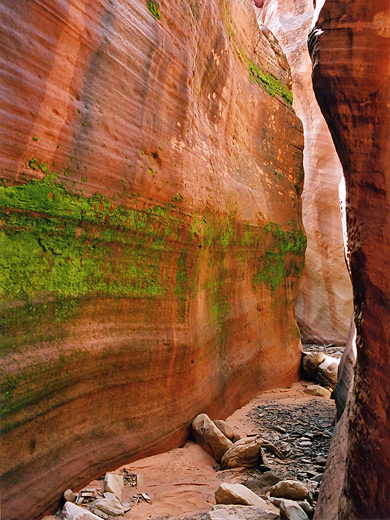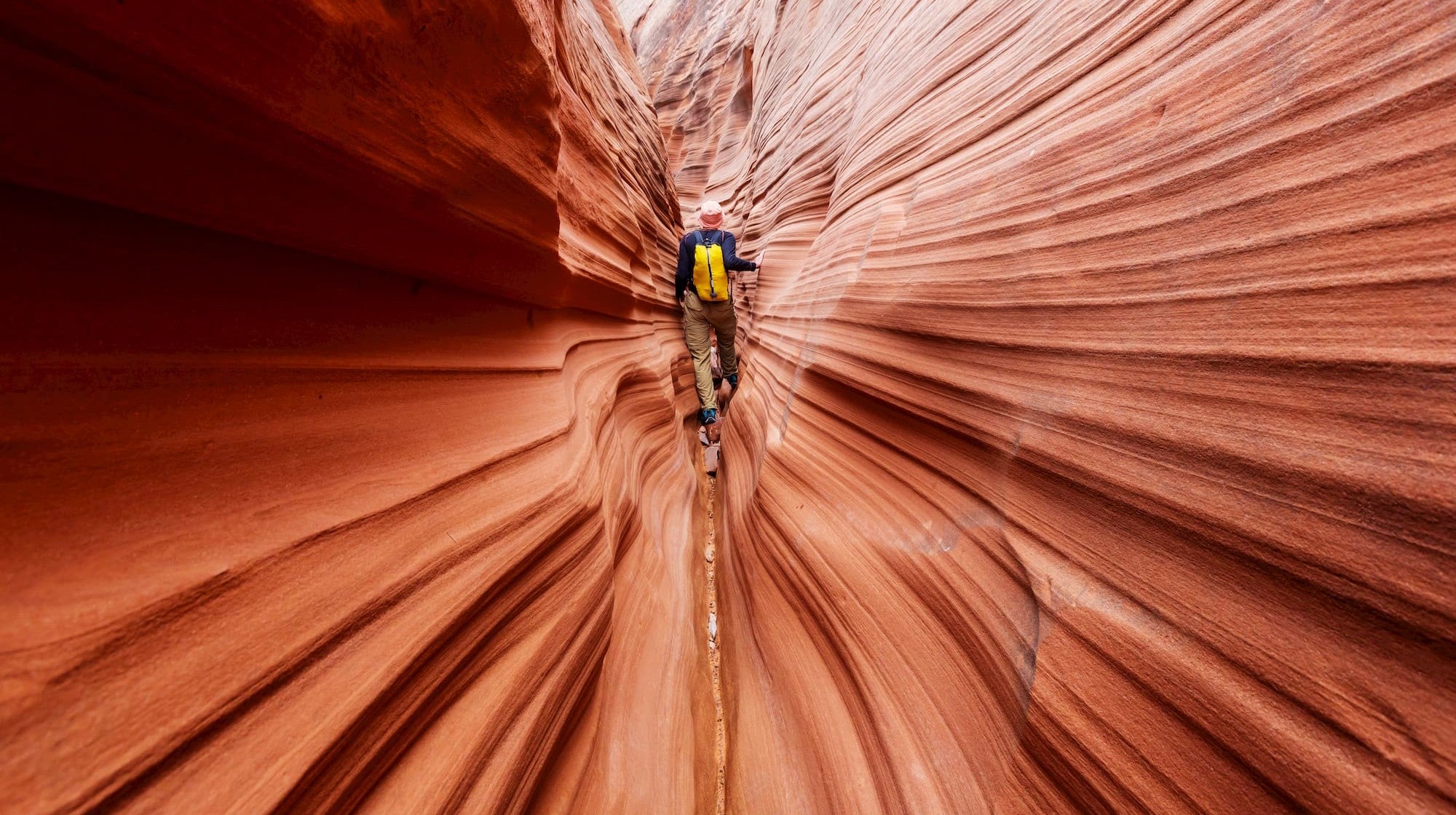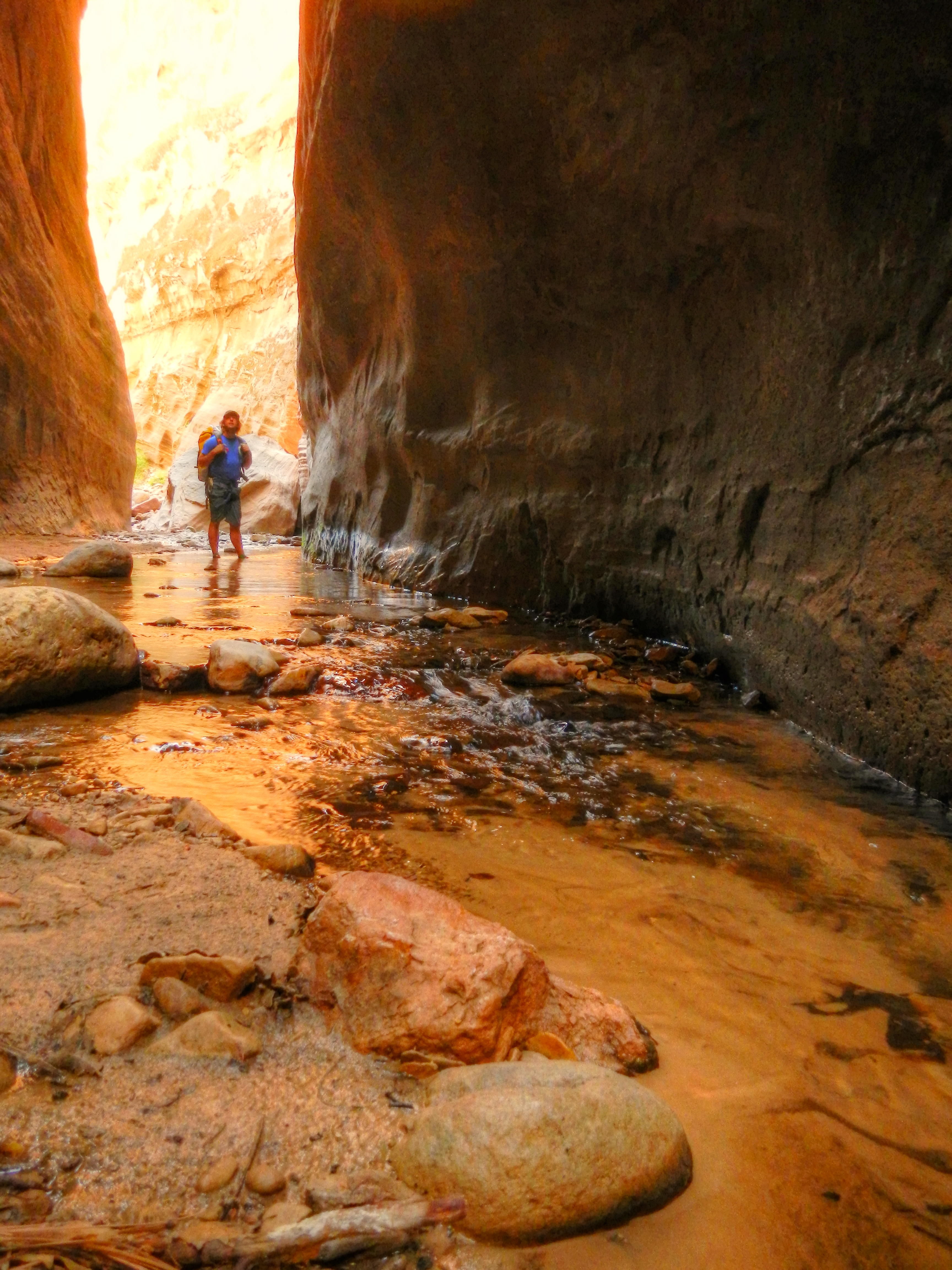Hidden Slot Canyons Utah
Posted By admin On 11/04/22Slot canyons are narrow gorges in soft rocks like Utah’s layered sedimentary deposits. They are named for their narrow width, often squeezing down to a sliver. It is said that Utah has the largest concentration of slot canyons in the world, and many of them are easily accessible. Red Hollow is a short, easy, and scenic slot canyon just outside of Zion National Park, Utah. This is a good slot canyon for beginners with easy scrambling in some places. The trailhead is about 18 miles from the eastern entrance of Zion National Park, located in the small town of Orderville.
Petroglyph Pools to Slot Canyon is a 1.1 mile moderately trafficked out and back trail located near Springdale, Utah that features a waterfall and is rated as moderate. The trail is primarily used for hiking and nature trips and is best used from March until November. Utah is a land of hidden slot canyons, high adventure and incredible national parks—the kind of place that can remind you in an instant—as you splash through a rapid for the first time, squeeze through a crack in the earth or stand beneath a rock arch at sunset—that life is about how you choose to spend it.
It’s no secret that Zion National Park is one of the most visited national parks in the United States. Attendance has risen steadily over the past decade, setting a new visitation record of 4.4 million visitors in 2017. But don’t let the growing crowds deter you from visiting Utah’s oldest national park. The majority of Zion’s visitors generally stick to the main canyon area, leaving the less traveled—yet equally majestic—cliffs and canyons waiting to be explored. Are you ready to experience Utah?
Discover a new side of Zion with these seven hidden gems.
1. Secret Slot Canyons
The thrill of hiking, rappelling and wading through Zion’s water-carved sandstone landscape is a major draw for slot canyon adventurers from all around the world. While most Zion visitors are familiar with the renowned Zion Narrows, others look to lesser known slot canyons for canyoneering adventures. Two must-see secrets are Mystery Canyon and Echo Canyon.
- Mystery Canyon is considered one of the crown jewels of technical canyoneering adventures in Zion. From the East Mesa trailhead, this hike begins with a steep rappel into the narrow, sculpted slot canyon, and ends with a final rappel down Mystery Falls into the Zion Narrows. A canyoneering permit is required, and the park limits access to 12 hikers each day.
- Echo Canyon offers a less technical slot canyon experience. Hidden in the heart of Zion Canyon, Echo Canyon is famous for its switchbacks and impressive views of Angels Landing.This secret slot canyon consists of several short rappels under 30 feet, and takes about three to four hours to complete. Be prepared to get wet with plenty of swimming and wading. A backcountry permit is required for this canyoneering adventure.
Photo Credit: Mystery Canyon, @sammyb_canyoneering
2. The Best View in Utah
When people think of the most thrilling hike to reach the best view in Zion, thoughts often go straight to Angels Landing. As it turns out, there’s an even more spectacular viewpoint. At 6,521 feet, Observation Point is nearly 1,000 feet higher than Angels Landing, and is one of the best viewpoints to capture the grandeur of Zion National Park’s vast expanse. In fact, Backpacker magazine named Observation Point as the best view in Utah.
Reaching Observation Point from the Zion Canyon floor requires an epic, 8-mile round-trip hiking adventure along the East Rim Trail that ascends more than 2,100 feet to reach the sweeping canyon view. What many hikers don’t know is that there’s a secret way to reach Observation Point’s same sweeping vista without the 2,148-foot climb. Accessing the trail from the eastern plateau of Zion National Park eliminates the massive uphill climb with a breathtaking hike through Ponderosa pine forest. The time and energy saved by hiking to Observation Point across Zion Ponderosa is invaluable—and the reward is the same magnificent 270-degree view.
Photo Credit: Getty Images
3. Secret Waterfall
Located within Pine Creek Canyon, this serene and remote waterfall is one of Zion’s best-kept secrets. The waterfall flows year-round and the swimming hole is perfect for cooling off on a hot summer day. The round-trip hike is relatively short but rugged. The 0.7-mile out-and-back trek requires some boulder scrambling and stream crossings that are well worth the effort. When you arrive at the spectacular 15-foot waterfall, you may never want to leave.
Photo Credit: Pine Creek Waterfall, @cara_lilyy
4. Hidden Petroglyphs
The majority of visitors flock to Zion for the scenery and outdoor activities, unaware of secret petroglyphs adorning Zion’s red sandstone walls. Paiute, Anasazi, Fremont and other ancient peoples have occupied Zion’s canyons and plateaus for thousands of years, and proof of their existence endures throughout the region. Inside Zion, Petroglyph Canyon is a fascinating rock art site featuring two panels with over 150 symbols created by one of Zion’s ancient cultures. The rock art is highly protected and largely unadvertised, but accessible to visitors who obtain special permission from the Zion National Park Visitor Center.
Photo Credit: Petroglyph Canyon, @29_bea
5. Best Hike for Kids
A hike doesn’t have to be long and challenging to be satisfying—especially with the kids in tow. The Canyon Overlook Trail is a short and sweet, kid-friendly hike without huge crowds. Beginning at the parking lot east of the Zion-Mt. Carmel tunnel, the 1-mile round-trip trail follows the hillside above Pine Creek Canyon to a large overlook with sweeping views of the Zion-Mt. Carmel tunnel windows, Zion Canyon, Streaked Wall and East Temple. Warning: There is a 163-foot elevation gain on this trail, so assess energy levels before you begin. For most families looking for a short hike with a great view, Canyon Overlook Trail is the best pick in the park.
Photo Credit: Canyon Overlook Trail, @bzwang43
6. Secret Arch
Zion’s main canyon tends to get most of the attention—and that’s okay, because it means the Kolob Canyon area is largely unvisited. This quieter section of the park features a 5-mile scenic drive and access to beautiful remote hikes, like La Verkin Creek and Taylor Creek trails. Hidden inside a small canyon is one of Zion’s best-kept secrets: Kolob Arch. The massive sandstone arch is one of the world’s largest free-standing arches, spanning 287 feet and second only to Utah’s renowned Landscape Arch.
Photo Credit: Kolob Arch, @iridescent_luminescence
7. Best Campgrounds

One of the best ways to experience Zion’s splendor is spending the night under the stars. The Watchman Campground is close to the park’s south entrance and can accommodate both tents and RVs. Reservations are recommended and can be made up to six months in advance for campgrounds, 176 tent sites, two wheelchair accessible sites or six group sites. However, reservations for the campground inside Zion National Park fill up fast, so Zion visitors need another option. Zion Crest Campground, located near the park’s east entrance, offers a high-altitude camping experience on the East Zion plateau above Zion National Park. Bordering the park’s boundary, Zion Crest features 50 shaded tent camping sites plus RV spaces with full hook-ups and plenty of overflow camping. More perks include an on-property restaurant, a two-tiered swimming pool, hot tub and mini golf course.
Photo Credit: Zion Crest Campground
Are you ready for an adventure? Learn more about Utah State Parks and Recreation.

Overview
Sat 33 16 | Sun 35 15 | Mon 38 17 | Tue 39 17 | Wed 32 15 |
| View Full Weather Details | ||||
Recent Trip Comments
Sat 33 16 | Sun 35 15 | Mon 38 17 | Tue 39 17 | Wed 32 15 |
| View Full Weather Details | ||||
Recent Trip Comments
The San Rafael Swell is a large remote area in central/eastern Utah, that is split in half by Interstate 70. It extends from near Hanksville to the south all the way north to near Price, and from Green River on its eastern side for about 70 miles west, encompassing over 2000 square miles. Access is usually made via I-70, or Price for the northern Swell, while I-70 and highway 24 provide access to the southern portion of the swell.
The Swell is very diverse. The eastern and southern reef sections contain many great narrow slot canyons, while the interior of the Swell boasts expansive flat areas, broad canyons, cliffs, and towers. There are many remnants of old uranium mines, homesteads, and signs of Indian occupation. It goes without saying, but always stay out of, and away from any old mines you may come across. They are unstable, and may contain deadly gases.
Due to the remoteness, always have extra food, water, and fuel when venturing off pavement. Most areas of the swell require a significant drive from pavement to access them.
Native Americans clearly visited and inhabited parts of the Swell. Buckhorn Wash, Cottonwood Wash, Rochester Art Panel, and other areas show the pictograph and petroglyph evidence they left behind. Even the drier eastern reef of the Swell has a few panels indicating Indians at the very least past through that dry and desolate area.
Early pioneers and settlers carved out small ranches in the area during the late 1800's, and there is still a fair amount of cattle that call the Swell home during various seasons. Several cabins from the original settlers are still standing and interesting to visit.
By the late 1800's and early 1900's, Uranium was discovered in the Swell, and mining began. Temple Mountain was one of the first areas mined and a small settlement setup nearby to support the miners. This was on a small scale until the Uranium boom of the 1950's, when miners flocked to the Swell. Between 1950 and 1960, thousands of claims were made and most of the roads that are used today were created in attempts to find Uranium. Most of the claims never struck it rich, though Hidden Splendor was a success story, selling for $9 million in 1954. It must have been an exciting time to be a prospector in the Swell. By 1960, most of the mines were abandoned and shut down. There are many remnants from this era visible throughout the Swell.
It wasn't until 1970 that the interstate (I-70) was opened across the Swell. The engineering that went into designing the road is impressive, and the stretch from Green River to Salina is the longest stretch of interstate in the US that does not have any services. (110 miles) With the interstate, access to the interior sections became substantially easier, and recreation in the Swell ramped up.
In more recent times, off road enthusiasts, hikers, climbers and canyoneers have discovered the Swell and its charms. Many of the more remote areas have become Wilderness Study Areas, with some talk of the area being designed a national monument.
There are none! In all seriousness, take all the fuel, food, water, and supplies you will need. Green River, Price, and Hanksville provide the nearest services. Hanksville is quite small, with a few gas stations, a small grocery store, and a couple of restaurants and hotels. Many of these close during the winter. Green River, being on the interstate, has a fair number of services, while Price is a full service small town.
The BLM maintains a campground at the San Rafael Bridge in Buckhorn wash, but it has no services other than picnic tables and a pit toilet. No water.
Aside from the BLM Campground, camping is pretty much a free-for-all. Lots of amazing spots. Don't create new fire rings or trample vegetation, there are plenty of washes or existing sites to camp in. With all camping: Practice low impact techniques, and pack out all garbage.
Due to the large elevation difference between the reef, and the interior of the Swell, something can be found to do most anytime of the year. For technical canyons, spring and fall can be pleasant times, but may require wetsuits. Summer can be hot, and may be better suited to hiking and exploring the higher elevations. In winter, hiking and exploring the eastern and southern reefs can be perfect.
Bugs can be brutal in the spring and summer months, go prepared.
Hiking Little Wild Horse, spending the day at Goblin Valley, or visiting petroglyphs in Buckhorn Wash are great recommendations for family fun. For the more technically inclined, canyoneering the Upper Black Box, Quandary, Knotted Rope and many others offer great beauty and fun. Some of the technical canyons contain keeper potholes. Go prepared!
Area Map
Trips
Canyoneering
Climbing

Floating
Hiking
